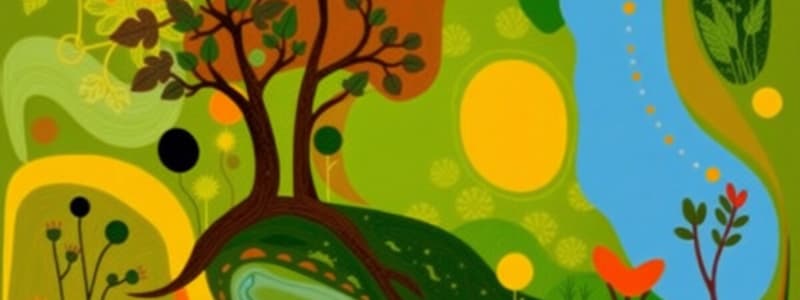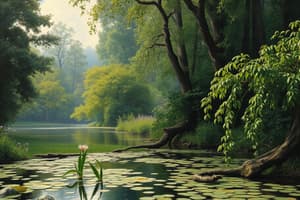Podcast
Questions and Answers
Which of the following statements is true about the 10% Law of Energy?
Which of the following statements is true about the 10% Law of Energy?
- 90% of the energy is transferred from one trophic level to the next, the remaining 10% is lost to the environment.
- 10% of the energy is transferred from one trophic level to the next, the remaining 90% is lost to the environment. (correct)
- 90% of the energy is transferred from one trophic level to the next, the remaining 10% is used for metabolic processes by the organism at the previous level.
- 10% of the energy is transferred from one trophic level to the next, the remaining 90% is used for metabolic processes by the organism at the previous level.
Which of the following is an example of an abiotic component of an ecosystem?
Which of the following is an example of an abiotic component of an ecosystem?
- A tree
- A fish
- Sunlight (correct)
- A bird
What is the main reason for the limited length of food chains?
What is the main reason for the limited length of food chains?
- Increasing availability of predators at higher trophic levels.
- Increasing competition among organisms at higher trophic levels.
- Decreasing availability of energy at higher trophic levels. (correct)
- Decreasing availability of food at higher trophic levels.
Which of the following are considered producers in an ecosystem?
Which of the following are considered producers in an ecosystem?
Which of the following is NOT a method of waste management aimed at reducing environmental impact?
Which of the following is NOT a method of waste management aimed at reducing environmental impact?
What is the primary reason for biomagnification occurring in food chains?
What is the primary reason for biomagnification occurring in food chains?
A garden would best be classified as which type of ecosystem?
A garden would best be classified as which type of ecosystem?
Which of these waste materials is classified as biodegradable?
Which of these waste materials is classified as biodegradable?
Which of the following is NOT an example of a terrestrial ecosystem?
Which of the following is NOT an example of a terrestrial ecosystem?
What is the primary role of the ozone layer in the atmosphere?
What is the primary role of the ozone layer in the atmosphere?
What is the role of decomposers in an ecosystem?
What is the role of decomposers in an ecosystem?
The relationship between a cat and a mouse in a food chain represents which trophic levels?
The relationship between a cat and a mouse in a food chain represents which trophic levels?
Which of these is a consequence of ozone layer depletion?
Which of these is a consequence of ozone layer depletion?
What is the primary reason for the thinning of the ozone layer?
What is the primary reason for the thinning of the ozone layer?
Which of these is NOT considered a sustainable waste management practice?
Which of these is NOT considered a sustainable waste management practice?
Which international agreement focused on phasing out ozone-depleting substances?
Which international agreement focused on phasing out ozone-depleting substances?
Flashcards
Environment
Environment
Everything surrounding us, including living and non-living things.
Ecosystem
Ecosystem
A community where living and non-living components are interconnected.
Natural Ecosystem
Natural Ecosystem
Ecosystems that occur naturally, like forests and oceans.
Biotic Components
Biotic Components
Signup and view all the flashcards
Producers
Producers
Signup and view all the flashcards
Trophic Levels
Trophic Levels
Signup and view all the flashcards
Food Chain
Food Chain
Signup and view all the flashcards
10% Law of Energy
10% Law of Energy
Signup and view all the flashcards
Biomagnification
Biomagnification
Signup and view all the flashcards
Bioaccumulation
Bioaccumulation
Signup and view all the flashcards
Biodegradable Waste
Biodegradable Waste
Signup and view all the flashcards
Non-biodegradable Waste
Non-biodegradable Waste
Signup and view all the flashcards
Composting
Composting
Signup and view all the flashcards
Ozone Layer
Ozone Layer
Signup and view all the flashcards
Ozone Depletion
Ozone Depletion
Signup and view all the flashcards
Montreal Protocol
Montreal Protocol
Signup and view all the flashcards
Study Notes
Environment and Ecosystem
- Environment encompasses all living and non-living things surrounding us.
- An ecosystem is a community where living and non-living components interact and depend on each other.
- Examples of ecosystems are forests, lakes, and oceans.
- Ecosystems are categorized as:
- Natural ecosystems: Naturally occurring, like forests, lakes, and oceans.
- Artificial ecosystems: Created by humans, examples include gardens and aquariums.
- Natural ecosystems are further divided into:
- Aquatic ecosystems: Water-based, such as marine and freshwater ecosystems.
- Terrestrial ecosystems: Land-based, including forests, deserts, and grasslands
Components of an Ecosystem
- Biotic components: Living parts of an ecosystem, encompassing plants and animals.
- Abiotic components: Non-living parts of an ecosystem, involving air, water, soil, sunlight, and minerals.
- Biotic components are categorized as follows:
- Producers: Organisms that create their food, like plants.
- Consumers: Organisms that rely on other organisms for food. Consumers are classified as:
- Primary consumers (herbivores): Consume producers, for example, rats.
- Secondary consumers (carnivores): Consume primary consumers, like cats.
- Tertiary consumers (carnivores): Consume secondary consumers, such as tigers.
- Decomposers: Bacteria and fungi that break down dead plants and animals, returning nutrients to the ecosystem.
Food Chain and Food Web
- Food Chain: A linear sequence describing feeding relationships, showing who eats whom.
- Food Web: A complex network of interconnected food chains, illustrating diverse feeding relationships.
- Trophic levels: An organism's position in a food chain, representing its feeding level:
- Trophic level 1: Producers (plants)
- Trophic level 2: Primary consumers (herbivores)
- Trophic level 3: Secondary consumers (carnivores)
- Trophic level 4: Tertiary consumers (top carnivores).
10% Law of Energy
- Only 10% of energy transfers from one trophic level to the next. The remaining 90% is lost as heat or used in life processes.
- This limits food chains to typically three or four trophic levels due to dwindling energy.
Biomagnification and Bioaccumulation
- Biomagnification: Toxic chemicals concentrate in higher trophic levels as organisms consume others with accumulated toxins.
- Examples: Mercury builds up in fish, potentially impacting humans.
Garbage Disposal and Management
- Garbage types:
- Biodegradable waste: Breaks down through microorganisms, like vegetable scraps.
- Non-biodegradable waste: Doesn't break down by microorganisms, such as plastic.
- Waste management methods include:
- Biogas plants: Convert biodegradable waste into biogas.
- Sewage treatment: Cleans wastewater.
- Landfilling: Buries non-biodegradable waste.
- Composting: Decomposes biodegradable waste into fertilizer.
- Recycling and reuse: Reprocesses or reuses materials.
- Incineration: Burns waste at high temperatures to reduce volume and sterilize hazardous materials.
Ozone Layer Depletion
- Ozone (O3): Atmospheric layer absorbing harmful UV radiation.
- Ozone depletion: Thinning of the ozone layer due to harmful chemical releases, mainly CFCs.
- CFCs: Released from refrigerants, air conditioners, and industrial processes.
- CFC breakdown in the stratosphere releases chlorine atoms, reacting with and destroying ozone molecules.
- Consequences of depletion: Increased UV radiation, increasing health concerns such as skin cancer and cataracts.
- UNEP: Works on international agreements, like the Montreal Protocol, to phase out ozone-depleting substances.
Studying That Suits You
Use AI to generate personalized quizzes and flashcards to suit your learning preferences.




